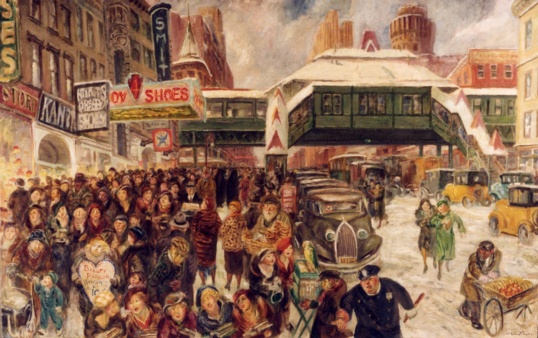
Herbert Hoover was president when the stock market crashed in October of 1929. Although he had a reputation for humanitarianism, Hoover refused to take bold actions as the U.S. economy headed for the bottom. In the 1932 election, Americans had become so disappointed in Hoover's inaction that a majority voted for Franklin D. Roosevelt, who had pledged "a new deal for the American people." Roosevelt's New Deal was comprised of numerous federal programs and policies — some call them an "alphabet soup" for their myriad acronyms — intended to promote economic recovery and social reform. The most pressing need was to put Americans back to work, and some funds went specifically to assist artists, dramatists, musicians, and writers.
Illustrating the context of New Deal art is this painting by Ashcan artist John Sloan. It depicts a New York City street scene at the time New Deal art programs were getting under way.

John Sloan (American, 1871-1951), 14th Street at 6th Avenue, c. 1935, oil on wood panel, US General Services Administration, thanks to Charles Terrill and his family. Sloan placed signs — blue eagle in a red frame — supporting the NRA (a federal program that fixed prices) under the "SHOES" sign, and another in the windshield of a parked car. Sloan may have portrayed himself in the foreground wearing a brown cap.
In order to channel subsidies to struggling artists, the federal government employed them through several bureaucracies:
The Public Works of Art Project (PWAP) in the Civil Works Administration
(CWA) was the first of these agencies. It spent $1,034,754 hiring
more than 3,700 artists for five months in the winter of 1933-34
to produce 6,800 easel paintings, 6,500 sculptures,
2,600 print designs,
and about 400 murals.
The Section of Painting and Sculpture (SPS) paid artists to produce more than 108,000 easel paintings, 17,000 sculptures, 11,000 print designs, and 2,500 murals. FAP artists are especially credited with their revival of printmaking, including the development of silkscreen techniques for mass-producing posters. SPS artists had a particularly public impact with the murals they painted in post offices and other government buildings across the country. In addition SPS operated over 100 Community Art Centers, and compiled a 20,000 piece Index of American Design. Its artists also produced models, photographs, and many other objects.
The Works Progress Administration (WPA) was created in 1935. Its Federal Arts Project (FAP), also started that year, hired 5,000 artists to create 108,000 easel paintings, 17,700 sculptures, 11,200 print designs, and 2,500 murals.
The Resettlement Administration (RA) later became the Farm Security Administration (FSA) — both in the Agriculture Department — hired photographers to document life in rural America. Together these two projects produced 122,000 black-and-white negatives, 66,000 black-and-white photographic prints, and about 650 color transparencies. Other agencies including the WPA, the Bureau of Agricultural Economics, the Rural Electrification Administration, and the Civilian Conservation Corps sponsored smaller photographic projects. Participating photographers included: Walker Evans (1903-1975), Dorothea Lange (1895-1965), Russell Lee, and Ben Shahn (1898-1969).
None of the New Deal programs succeeded in convincing the representatives of the American people that federal art patronage was such an important activity that it should be considered as a proper function of government, and therefore be continued. All New Deal art programs died with the arrival of World War II. In the prosperity that followed the war, the objective of supporting artists during a crisis could not be maintained. Not until the arrival of the National Endowment for the Arts (NEA) and the flourishing of various public art programs have U.S. government monies funded artists' works, though not to the degree that the New Deal programs did.
Among the thousands of painters,
printmakers, and sculptors who participated in one or more of
the New Deal art programs were:
Also see American art, American Gothic, Art Deco, Ashcan school, Federal Art Project (FAP), Fourteenth Street school, Harlem Renaissance, Index of American Design, lithography, Public Works of Art Project (PWAP), Regionalism, Section of Painting and Sculpture (SPS), social realism, socialist realism, Synchromism, and Works Progress Administration (WPA).
https://inform.quest/_art